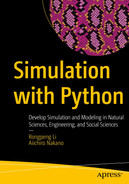Simulation with Python
Develop Simulation and Modeling in Natural Sciences, Engineering, and Social Sciences

The Apress logo.
This Apress imprint is published by the registered company APress Media, LLC, part of Springer Nature.
The registered company address is: 1 New York Plaza, New York, NY 10004, U.S.A.
To Yan, for everything.
—Ron
This book is a small gift to a younger me, probably in high school or even earlier. This book is by no means written for seasoned researchers or professionals. It should be treated as the first bite of ice cream which makes you want more.
This book contains several scientific simulation topics, ranging from physics, biology, and even finance. The approach is very gentle and newcomer friendly. I tried to remove the majority of the complexity that I would learn with the knowledge and scientific training I already had. Instead, I did my best to keep the most important essence in each topic. The persona in my mind is a young and curious student who just got the first computer and learned some basic programming, probably from the older brother. This student, pictured as a younger me, would be able to follow the content of this book without any difficulty and get amazed by the beautiful visualizations and scientific conclusions.
Each topic in this book is rather independent. According to the level of technical difficulty and required background knowledge, I categorize the chapters into three groups. Readers can start with any chapter.
Easy:
Chapter 1: Calculating Pi with Monte Carlo Simulation
Chapter 4: Balls in a 2-D Box, a Simple Physics Engine
Medium:
Chapter 2: Markov Chain, a Peek into the Future
Chapter 3: Multi-armed Bandits, Probability Simulation, and Bayesian Statistics
Chapter 7: Rock, Scissors, and Paper: Multi-agent Simulation
Chapter 8: Disease Spreading, Simulating COVID-19 Outbreak
Chapter 9: Misinformation Spreading and Simulations on a Graph
Hard:
Chapter 5: Percolation, Threshold, and Phase Change
Chapter 6: Queuing System: How Stock Trades Are Made
I hope you enjoy this book as much as I do.
Rongpeng Li would like to thank all his previous students for the inspiration of this book, from readers at local libraries to learners in his Zoom classroom.

A photo of Rongpeng Li.

A photo of Aiichiro Nakano.

A photo of Kacie Webster.
